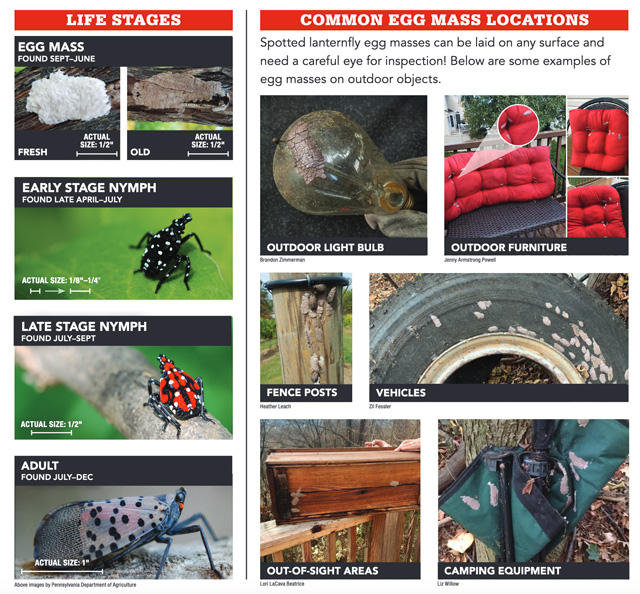By Marian Fabian
Spotted lanternflies are an invasive species, first seen in a supply center located in Berks County, Pennsylvania. They have been making their way into the United States since September of 2014 and in 2021 they have become a growing issue in New Jersey, killing crops on farmland essential to residents. In 2021, federal officials instructed New Jersey residents to “kill on site,” in other words, have no mercy. The Pennsylvania Department of Agriculture had a similar message, “Kill it! Squash it, smash it…just get rid of it. In the fall, these bugs will lay egg masses with 30-50 eggs each. These are called bad bugs for a reason, don’t let them take over your county next.”
Even though they are harmless to animals and humans, the state is looking for help exterminating these destructive insects. The spotted lanternfly may seem to be an attractive butterfly or moth when its wings are outstretched, however, it is, in fact, a plant hopper. In keeping with its name, these creatures are excellent jumpers and they are also plant-eaters. There are over 12,500 species of plant hoppers worldwide.
South Korea and the United States both saw an influx of these insects that expanded at a fast pace. Despite the fact that spotted lanternflies have wings and can fly, they often only travel small distances. The unborn (egg) stage of their life is most likely when they are being moved around. Large clusters of 30-50 eggs are laid at a time. A waxy mud-colored material that dries and splits, known as an ootheca, is applied on them, and it may be used to conceal them quite well. These insects like to deposit their eggs on flat surfaces, such as concrete or asphalt. They might also lay their eggs on outdoor furniture or a box. People may then unwittingly carry the eggs to different states or even countries. Stowaway individuals or eggs in a shipping container, for example, might have brought the bug to the United States.
They are also now capable of reproducing without hindrance. Local predators, such as parasitic wasps, it is believed, help to keep spotted lanternfly populations under control in their natural habitats. However, in areas where they have been introduced, there seem to be fewer predators having an influence on their population.
Lanternflies leave a mark wherever they go. When they lay their eggs, they leave sap on vines, trees, or crops. This sap is called honeydew and is a sugary liquid. The nectar of honeydew attracts other insects such as wasps, ants, and bees, but it may also encourage the growth of mold on the plant that it is produced on. This is a fungal illness that prevents the plant from being able to photosynthesize and produce the energy it needs to live and thrive. It is spread by fungi. It is especially harmful in areas where a high number of insects cluster to feed on one another.
“They’re all over the place, destroying the beauty of the homes in the neighborhood,” said Gladys Castro, a Haddonfield, NJ, resident.
Lanternflies undergo four instars (also known as stages of development) before they mature into adults. The small nymphs are black with white dots during the first three instars after hatching. They grow to a length of 1.5 centimeters by the fourth stage, when they become red and black with white markings.
When they mature into winged adults, they undergo a dramatic shift in appearance. They are around 2.5 centimeters long and have light brown forewings covered in black dots at this early stage of development. Their hind wings become a brilliant crimson with black and white spots when it is frightened or prepares to take flight. They have black bands on the back of their abdomens. A generation of this species lasts just one year. The eggs of spotted lanternflies survive the winter and hatch in May. They remain active until December.
“Thankfully you don’t see them as much as the weather gets colder, so they shouldn’t be a problem until next spring,” said Robert Helder, a Haddonfield resident.
When introduced to new areas, sap-sucking insects like the spotted lanternfly may harm the plants they feed on. A few of them, such as oaks and black walnuts, are crucial to the economy. Grape vines can be severely damaged, putting at risk an industry worth billions of dollars in both South Korea and the United States.
The spotted lanternfly’s preferred plant is the Ailanthus altissima, often referred to as the tree of paradise, which has been successfully introduced into a handful of countries, including South Korea, Japan, and the United States, as well as most of Europe and the Middle East. But they aren’t picky. They’d be happy to munch on a wide range of fruit, decorative, and woody trees, as well as vines, vegetables, herbs, and cereals.




